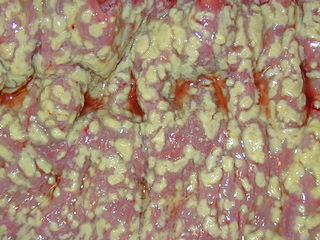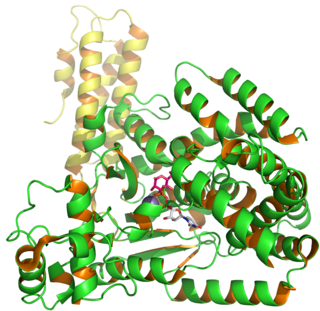
Clostridium botulinum is a Gram-positive, rod-shaped, anaerobic, spore-forming, motile bacterium with the ability to produce the neurotoxin botulinum.

Clostridium is a genus of Gram-positive bacteria, which includes several significant human pathogens, including the causative agent of botulism. The genus formerly included an important cause of diarrhea, Clostridium difficile, which was separated after 16S rRNA analysis. They are obligate anaerobes capable of producing endospores. The normal, reproducing cells of Clostridium, called the vegetative form, are rod-shaped, which gives them their name, from the Greek κλωστήρ or spindle. Clostridium endospores have a distinct bowling pin or bottle shape, distinguishing them from other bacterial endospores, which are usually ovoid in shape. Clostridium species inhabit soils and the intestinal tract of animals, including humans. Clostridium is a normal inhabitant of the healthy lower reproductive tract of women.

Clostridioides difficile infection, also known as Clostridium difficile infection, is a symptomatic infection due to the spore-forming bacterium Clostridioides difficile. Symptoms include watery diarrhea, fever, nausea, and abdominal pain. It makes up about 20% of cases of antibiotic-associated diarrhea. Complications may include pseudomembranous colitis, toxic megacolon, perforation of the colon, and sepsis.
Oxobacter is a genus of Gram-positive obligately anaerobic rod-shaped acetogenic bacteria. The sole species in the genus is Oxobacter pfennigii, formerly known as Clostridium pfennigii. This endospore-forming microorganism catabolizes pyruvate to acetate and CO2, while sugars and amino acids are not utilized as energy sources.

Clostridium difficile toxin B is a toxin produced by the bacteria Clostridium difficile. C. difficile produces two major kinds of toxins that are very potent and lethal; an enterotoxin and a cytotoxin.
Thermoanaerobacter is a genus in the phylum Firmicutes (Bacteria). Members of this genus are thermophilic and anaerobic, several of them were previously described as Clostridium species and members of the now obsolete genera Acetogenium and Thermobacteroides
Thermoanaerobacter kivui is a thermophilic, anaerobic, non-spore-forming species of bacteria.
Caloramator fervidus, previously known as Clostridium fervidus, is a bacterium belonging to the Firmicutes.
Caloramator, is a genus of bacteriae belonging to the Firmicutes.
Filifactor villosus, previously known as Clostridium villosum, is a bacterium belonging to the Firmicutes.
Filifactor, is a genus of bacteriae belonging to the Firmicutes.
Moorella thermoacetica, previously known as Clostridium thermoaceticum, is an acetogenic, thermophilic, strictly anaerobic, endospore-forming, bacterium belonging to the phylum Firmicutes.
Moorella is a genus of bacteria belonging to the phylum Firmicutes.
Moorella thermoautotrophica, previously known as Clostridium thermoautotrophicum, is a rod-shaped, endospore-forming bacterium belonging to the phylum Firmicutes. It is thermophilic, strictly anaerobic and acetogenic, and was isolated from a hot spring in Yellowstone National Park USA.
Oxobacter pfennigii, previously known as Clostridium pfennigii, is a bacterium belonging to the Firmicutes.
Oxalophagus is a genus of bacteria belonging to the Firmicutes. Up to now, only one species of this genus is known, Oxalophagus oxalicus
Eubacterium barkeri, previously known as Clostridium barkeri, is a bacterium belonging to the Firmicutes.
Paenibacillus durus, previously known as Clostridium durum and Paenibacillus azotofixans, is a bacterial species belonging to the Firmicutes.
Thermoanaerobacter thermocopriae, previously known as Clostridium thermocopriae is a bacterium belonging to the Firmicutes.
Thermoanaerobacterium thermosaccharolyticum, previously known as Clostridium thermosaccharolyticum is a bacterium belonging to the Firmicutes.




